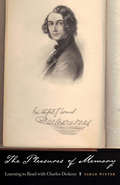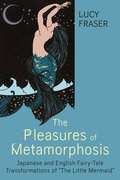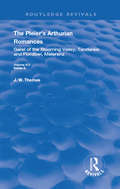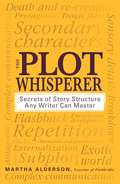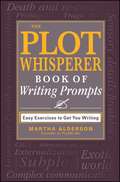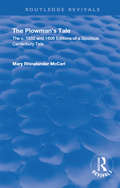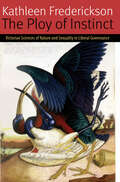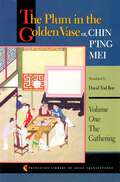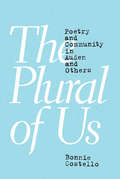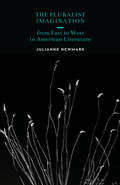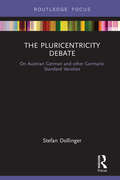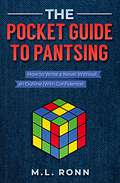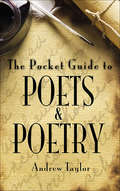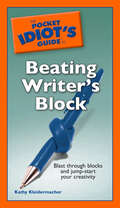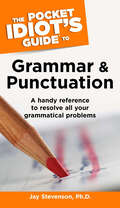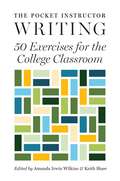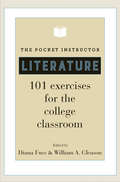- Table View
- List View
The Pleasures of Memory: Learning to Read with Charles Dickens
by Sarah WinterWhat are the sources of the commonly held presumption that reading literature should make people more just, humane, and sophisticated? Rendering literary history responsive to the cultural histories of reading, publishing, and education, The Pleasures of Memory illuminates the ways in which Dickens’s serial fiction shaped not only the popular practice of reading for pleasure and instruction but also the school subject we now know as “English.”Winter shows how Dickens’s serial fiction instigated specific reading practices by reworking the conventions of religious didactic tracts from which most Victorians learned to read. Incorporating an influential associationist psychology of learning founded on the cumulative functioning of memory, Dickens’s serial novels consistently led readers to reflect on their reading as a form of shared experience.Dickens’s celebrity authorship, Winter argues, represented both a successful marketing program for popular fiction and a cultural politics addressed to a politically unaffiliated, social-activist Victorian readership. As late-nineteenth century educational reforms consolidated British and American readers into “mass” populations served by state school systems, Dickens’s beloved novels came to embody the socially inclusive and humanizing goals of democratic education.
The Pleasures of Metamorphosis: Japanese and English Fairy Tale Transformations of "The Little Mermaid" (Series in Fairy-Tale Studies)
by Lucy FraserLucy Fraser’s The Pleasures of Metamorphosis: Japanese and English Fairy-Tale Transformations of “The Little Mermaid” explores Japanese and English transformations of Hans Christian Andersen’s 1837 Danish fairy tale “The Little Mermaid” by focusing on pleasure as a means to analyze the huge variety of texts that transform a canonical fairy tale such as Andersen’s. Fraser examines over twenty Japanese and English transformations, including literary texts, illustrated books, films, and television series. This monograph also draws upon criticism in both Japanese and English, meeting a need in Western fairy-tale studies for more culturally diverse perspectives. Fraser provides a model for critical cross-cultural fairy tale analysis in her examination of the journey of a single fairy tale across two languages. The book begins with the various approaches to reading and writing fairy tales, with a history of “The Little Mermaid” in Japanese and English culture. Disney’s The Little Mermaid and Studio Ghibli’s Ponyo on the Cliff by the Sea are discussed as examples that simulate pleasurable physical experiences through animation’s tools of music and voice, and visual effects of movement and metamorphosis. Fraser then explores the literary effects of the fairy tale by male authors, such as Oscar Wilde, Tanizaki Jun’ichiro, and Abe Kobo, who invoke familiar fairy-tale conventions and delineate some of the pleasures of what can be painful enchantment with a mermaid or with the fairy tale itself. The author examines the portrayals of the mermaid in three short stories by Matsumoto Yuko, Kurahashi Yumiko, and Ogawa Yoko, engaging with familiar fairy tales, reference to fairy-tale research, and reflections on the immersive experience of reading. Women characters and authors are also hyperaware of the possible meanings of Andersen’s “The Little Mermaid” and of the fairy tale itself, furthering the discussion with Nonaka Hiiragi’s novel Ningyo-hime no kutsu, and D[di?]’s novel Sento no ningyo-hime to majo no mori, as well as an episode of the science fiction television series Dark Angel. Fraser concludes that the “pleasure” framework is useful for a cross-cultural study of creative engagements with and transformations of a particular fairy tale. Few studies have examined Japanese fairy-tale transformations to the extent that Fraser has, presenting fascinating information that will intrigue fairy-tale scholars and those wanting to learn more about the representation of pleasure behind the imaginative and fantastical.
The Pleasures of Reading in an Age of Distraction
by Alan JacobsIn recent years, cultural commentators have sounded the alarm about the dire state of reading in America. Americans are not reading enough, they say, or reading the right books, in the right way. In this book, Alan Jacobs argues that, contrary to the doomsayers, reading is alive and well in America. There are millions of devoted readers supporting hundreds of enormous bookstores and online booksellers. Oprah's Book Club is hugely influential, and a recent NEA survey reveals an actual uptick in the reading of literary fiction. Jacobs's interactions with his students and the readers of his own books, however, suggest that many readers lack confidence; they wonder whether they are reading well, with proper focus and attentiveness, with due discretion and discernment. Many have absorbed the puritanical message that reading is, first and foremost, good for you--the intellectual equivalent of eating your Brussels sprouts. For such people, indeed for all readers, Jacobs offers some simple, powerful, and much needed advice: read at whim, read what gives you delight, and do so without shame, whether it be Stephen King or the King James Version of the Bible. In contrast to the more methodical approach of Mortimer Adler's classic How to Read a Book(1940), Jacobs offers an insightful, accessible, and playfully irreverent guide for aspiring readers. Each chapter focuses on one aspect of approaching literary fiction, poetry, or nonfiction, and the book explores everything from the invention of silent reading, reading responsively, rereading, and reading on electronic devices. Invitingly written, with equal measures of wit and erudition,The Pleasures of Reading in an Age of Distraction will appeal to all readers, whether they be novices looking for direction or old hands seeking to recapture the pleasures of reading they first experienced as children.
The Pleier’s Arthurian Romances: Garel of the Blooming Valley, Tandareis and Floribel, Meleranz (Routledge Revivals #Vol. 91b)
by Der PleierPublished in 1992: The Pleier’s Arthurian Romances tells of stories during the time of King Arthur.
The Plot Whisperer
by Martha AldersonWhen it comes to writing bestsellers, it's all about the plot. Trouble is, plot is where most writers fall down--but you don't have to be one of them. With this book, you'll learn how to create stories that build suspense, reveal character, and engage readers--one scene at a time. Celebrated writing teacher and author Martha Alderson has devised a plotting system that's as innovative as it is easy to implement. With her foolproof blueprint, you'll learn to devise a successful storyline for any genre. She shows how to: Use the power of the Universal Story Create plot lines and subplots that work together Effectively use a scene tracker for maximum impact Insert energetic markers at the right points in your story Show character transformation at the book's climax This is the ultimate guide for you to write page-turners that sell!
The Plot Whisperer
by Martha AldersonWhen it comes to writing bestsellers, it's all about the plot. Trouble is, plot is where most writers fall down--but you don't have to be one of them. With this book, you'll learn how to create stories that build suspense, reveal character, and engage readers--one scene at a time.Celebrated writing teacher and author Martha Alderson has devised a plotting system that's as innovative as it is easy to implement. With her foolproof blueprint, you'll learn to devise a successful storyline for any genre. She shows how to:Use the power of the Universal Story Create plot lines and subplots that work togetherEffectively use a scene tracker for maximum impactInsert energetic markers at the right points in your storyShow character transformation at the book's climaxThis is the ultimate guide for you to write page-turners that sell!
The Plot Whisperer
by Martha AldersonWhen it comes to writing bestsellers, it's all about the plot. Trouble is, plot is where most writers fall down--but you don't have to be one of them. With this book, you'll learn how to create stories that build suspense, reveal character, and engage readers--one scene at a time.Celebrated writing teacher and author Martha Alderson has devised a plotting system that's as innovative as it is easy to implement. With her foolproof blueprint, you'll learn to devise a successful storyline for any genre. She shows how to:Use the power of the Universal Story Create plot lines and subplots that work togetherEffectively use a scene tracker for maximum impactInsert energetic markers at the right points in your storyShow character transformation at the book's climaxThis is the ultimate guide for you to write page-turners that sell!
The Plot Whisperer Book of Writing Prompts
by Martha AldersonDaily exercises guaranteed to spark your writing! The Plot Whisperer Book of Writing Prompts gives you the inspiration and motivation you need to finish every one of your writing projects. Written by celebrated writing teacher and author Martha Alderson, this book guides you through each stage of the writing process, from constructing compelling characters to establishing an unforgettable ending. Alderson also helps you get into the habit of writing creatively every day, with brand-new imaginative prompts, such as: Create an obstacle that interferes with the protagonist's goal and describe how that scene unfolds moment-by-moment. Provide sensory details of the story world and what your main character is doing at this very moment. Scan earlier scenes for examples of the protagonist's chief character flaw and develop it. He or she will need to overcome this flaw in order to achieve his or her ultimate goal. Show an issue or situation in the main character's life that needs attention and have him or her take the first step forward toward a course of action. Filled with daily affirmations, plot advice, and writing exercises, The Plot Whisperer Book of Writing Prompts will set your projects in the right direction--and on their way to the bestseller list!
The Plot Whisperer Book of Writing Prompts
by Martha AldersonDaily exercises guaranteed to spark your writing! The Plot Whisperer Book of Writing Prompts gives you the inspiration and motivation you need to finish every one of your writing projects. Written by celebrated writing teacher and author Martha Alderson, this book guides you through each stage of the writing process, from constructing compelling characters to establishing an unforgettable ending. Alderson also helps you get into the habit of writing creatively every day, with brand-new imaginative prompts, such as: Create an obstacle that interferes with the protagonist's goal and describe how that scene unfolds moment-by-moment. Provide sensory details of the story world and what your main character is doing at this very moment. Scan earlier scenes for examples of the protagonist's chief character flaw and develop it. He or she will need to overcome this flaw in order to achieve his or her ultimate goal. Show an issue or situation in the main character's life that needs attention and have him or her take the first step forward toward a course of action. Filled with daily affirmations, plot advice, and writing exercises, The Plot Whisperer Book of Writing Prompts will set your projects in the right direction--and on their way to the bestseller list!
The Plot Whisperer Book of Writing Prompts: Easy Exercises to Get You Writing
by Martha AldersonDaily exercises guaranteed to spark your writing!The Plot Whisperer Book of Writing Prompts gives you the inspiration and motivation you need to finish every one of your writing projects. Written by celebrated writing teacher and author Martha Alderson, this book guides you through each stage of the writing process, from constructing compelling characters to establishing an unforgettable ending. Alderson also helps you get into the habit of writing creatively every day, with brand-new imaginative prompts, such as:Create an obstacle that interferes with the protagonist's goal and describe how that scene unfolds moment-by-moment.Provide sensory details of the story world and what your main character is doing at this very moment.Scan earlier scenes for examples of the protagonist's chief character flaw and develop it. He or she will need to overcome this flaw in order to achieve his or her ultimate goal.Show an issue or situation in the main character's life that needs attention and have him or her take the first step forward toward a course of action.Filled with daily affirmations, plot advice, and writing exercises, The Plot Whisperer Book of Writing Prompts will set your projects in the right direction--and on their way to the bestseller list!
The Plot Whisperer: Secrets of Story Structure Any Writer Can Master
by Martha AldersonWhen it comes to writing bestsellers, it's all about the plot. Trouble is, plot is where most writers fall down--but you don't have to be one of them. With this book, you'll learn how to create stories that build suspense, reveal character, and engage readers--one scene at a time.Celebrated writing teacher and author Martha Alderson has devised a plotting system that's as innovative as it is easy to implement. With her foolproof blueprint, you'll learn to devise a successful storyline for any genre. She shows how to:Use the power of the Universal Story Create plot lines and subplots that work togetherEffectively use a scene tracker for maximum impactInsert energetic markers at the right points in your storyShow character transformation at the book's climaxThis is the ultimate guide for you to write page-turners that sell!
The Plowman's Tale: The c. 1532 and 1606 Editions of a Spurious Canterbury Tale (Routledge Revivals)
by Mary Rhinelander McCarlPublished in 1997: An edition of the literary virus that inserted itself into the Canterbury Tales and passed as authentic until the late 19th century. The virulent attack on the clergy made possible the Renaissance conception of Chaucer as a pre-Protestant English patriot.
The Ploy of Instinct: Victorian Sciences of Nature and Sexuality in Liberal Governance (Forms of Living)
by Kathleen FredericksonIt is paradoxical that instinct became a central term for late Victorian sexual sciences as they were elaborated in the medicalized spaces of confession and introspection, given that instinct had long been defined in its opposition to self-conscious thought. The Ploy of Instinct ties this paradox to instinct’s deployment in conceptualizing governmentality.Instinct’s domain, Frederickson argues, extended well beyond the women, workers, and “savages” to whom it was so often ascribed. The concept of instinct helped to gloss over contradictions in British liberal ideology made palpable as turn-of-the-century writers grappled with the legacy of Enlightenment humanism. For elite European men, instinct became both an agent of “progress” and a force that, in contrast to desire, offered a plenitude in answer to the alienation of self-consciousness.This shift in instinct’s appeal to privileged European men modified the governmentality of empire, labor, and gender. The book traces these changes through parliamentary papers, pornographic fiction, accounts of Aboriginal Australians, suffragette memoirs, and scientific texts in evolutionary theory, sexology, and early psychoanalysis.
The Plum in the Golden Vase or, Chin P'ing Mei, Volume One: The Gathering (Princeton Library of Asian Translations #56)
by David Tod RoyThe first volume of a celebrated translation of the classic Chinese novelThis is the first volume in David Roy's celebrated translation of one of the most famous and important novels in Chinese literature. The Plum in the Golden Vase or, Chin P’ing Mei is an anonymous sixteenth-century work that focuses on the domestic life of Hsi-men Ch’ing, a corrupt, upwardly mobile merchant in a provincial town, who maintains a harem of six wives and concubines. The novel, known primarily for its erotic realism, is also a landmark in the development of the narrative art form—not only from a specifically Chinese perspective but in a world-historical context.With the possible exception of The Tale of Genji (1010) and Don Quixote (1615), there is no earlier work of prose fiction of equal sophistication in world literature. Although its importance in the history of Chinese narrative has long been recognized, the technical virtuosity of the author, which is more reminiscent of the Dickens of Bleak House, the Joyce of Ulysses, or the Nabokov of Lolita than anything in the earlier Chinese fiction tradition, has not yet received adequate recognition. This is partly because all of the existing European translations are either abridged or based on an inferior recension of the text. This translation and its annotation aim to faithfully represent and elucidate all the rhetorical features of the original in its most authentic form and thereby enable the Western reader to appreciate this Chinese masterpiece at its true worth.
The Plural of Us: Poetry and Community in Auden and Others
by Bonnie CostelloThe Plural of Us is the first book to focus on the poet’s use of the first-person plural voice—poetry’s “we.” Closely exploring the work of W. H. Auden, Bonnie Costello uncovers the trove of thought and feeling carried in this small word. While lyric has long been associated with inwardness and a voice saying “I,” “we” has hardly been noticed, even though it has appeared throughout the history of poetry. Reading for this pronoun in its variety and ambiguity, Costello explores the communal function of poetry—the reasons, risks, and rewards of the first-person plural.Costello adopts a taxonomic approach to her subject, considering “we” from its most constricted to its fully unbounded forms. She also takes a historical perspective, following Auden’s interest in the full range of “the human pluralities” in a time of particular pressure for and against the collective. Costello offers new readings as she tracks his changing approach to voice in democracy. Examples from many other poets—including Walt Whitman, T. S. Eliot, Elizabeth Bishop, and Wallace Stevens—arise throughout the book, and the final chapter offers a consideration of how contemporary writers find form for what George Oppen called “the meaning of being numerous.”Connecting insights to philosophy of language and to recent work in concepts of community, The Plural of Us shows how poetry raises vital questions—literary and social—about how we speak of our togetherness.
The Pluralist Imagination from East to West in American Literature
by Julianne NewmarkThe first three decades of the twentieth century saw the largest period of immigration in U.S. history. This immigration, however, was accompanied by legal segregation, racial exclusionism, and questions of residents’ national loyalty and commitment to a shared set of “American” beliefs and identity. The faulty premise that homogeneity—as the symbol of the “melting pot”—was the mark of a strong nation underlined nativist beliefs while undercutting the rich diversity of cultures and lifeways of the population. Though many authors of the time have been viewed through this nativist lens, several texts do indeed contain an array of pluralist themes of society and culture that contradict nativist orientations. In The Pluralist Imagination from East to West in American Literature, Julianne Newmark brings urban northeastern, western, southwestern, and Native American literature into debates about pluralism and national belonging and thereby uncovers new concepts of American identity based on sociohistorical environments. Newmark explores themes of plurality and place as a reaction to nativism in the writings of Louis Adamic, Konrad Bercovici, Abraham Cahan, Willa Cather, Paul Laurence Dunbar, Charles Alexander Eastman, James Weldon Johnson, D. H. Lawrence, Mabel Dodge Luhan, and Zitkala-Ša, among others. This exploration of the connection between concepts of place and pluralist communities reveals how mutual experiences of place can offer more constructive forms of community than just discussions of nationalism, belonging, and borders.
The Pluricentricity Debate: On Austrian German and other Germanic Standard Varieties (Routledge Focus on Linguistics)
by Stefan DollingerThis book unpacks a 30-year debate about the pluricentricity of German. It examines the concept of pluricentricity, an idea implicit to the study of World Englishes, which expressly allows for national standard varieties, and the notion of "pluri-areality," which seeks to challenge the former. Looking at the debate from three angles – methodological, theoretical, and epistemological – the volume draws on data from German and English, with additional perspectives from Dutch, Luxembourgish, Swedish, Danish and Norwegian, to establish if and to what degree "pluri-areality" and pluricentricity model various sociolinguistic situations adequately. Dollinger argues that "pluri-areality" is synonymous with "geographical variation" and, as such, no match for pluricentricity. Instead, "pluri-areality" presupposes an atheoretical, supposedly "neutral", data-driven linguistics that violates basic science-theoretical principles. Three fail-safes are suggested – the uniformitarian hypothesis, Popper’s theory of falsification and speaker attitudes – to avoid philological incompatibilities and terminological clutter. This book is of particular interest to scholars in sociolinguistics, World Englishes, Germanic languages and linguists more generally.
The Pocket Guide to Classic Books (Pocket Guides)
by Kieran HughesEverything you need to know about classic literature in one handy guide by lecturer Maureen Hughes. Covering everything from the authors to the plays themselves and their common themes, accessibility is a key selling point with factboxes highlighting key or curious facts about the subject. Its size makes it the perfect stocking filler for the Christmas market or at anytime of the year for those wanting more information about what theyre reading or studying in a handy, pocket-sized guide.
The Pocket Guide to Pantsing: How to Write a Novel Without an Outline (with Confidence) (Author Level Up #13)
by M.L. RonnPantsers: do you want to ditch outlining forever but don't know how? Maybe you've tried to write by the seat of your pants, but you got lost in the weeds. Or, you just need some structure. Writing a novel without an outline is like solving a complex puzzle—daunting, but not impossible. Master this technique and you'll write stories that you never dreamed of--and readers will pay you for it. In this practical, no BS guide, prolific M.L. Ronn will talk about the pantsing process he's followed to write over 20 novels without an outline. You'll discover: A tried-and-true structure for writing your book without an outline How to win the war against self-doubt What to do when you get stuck, and exactly what to write next How to edit your novel as you go and produce a clean first & final draft Once you write your first novel without an outline, the next one will be much easier. All you need is practical advice. Click the buy button to take your writing skills to the next level. V1.0
The Pocket Guide to Poets and Poetry (Pocket Guides)
by Andrew TaylorContinuing the success of the Pocket Guide series, Andrew Taylors Pocket Guide to Poets and Poetry starts with a history of poetry, setting the poets and their work in the context of their time and the influence of their work including political agenda, festivities and historical celebrations and their chosen genre. The poets are reviewed with their individual biographies, including their genre and best works. A must for everyone interested in poetry, those looking for more information about their favorite poets, as well as seeking to discover new favorites. It will also appeal to collectors of the Pocket Guide series by Remember When which includes The Pocket Guide to the Classics and The Pocket Guide to Plays and Playwrights.
The Pocket Idiot's Guide to Beating Writer's Block: Blast Through Blocks and Jump-Start Your Creativity
by Kathy KleidermacherWrite it off, work it out, get it done. An eminently practical guide to getting unblocked and writing again, The Pocket Idiot&’s Guide® to Beating Writer&’s Block includes dozens and dozens of tips, exercises, prompts, and more that will get the creative juices flowing. From something as simple as finding or creating a more comfortable place to work, to assigning a week to strengthening one&’s weak points, this is the book to get writers back on track. —Takes a practical, not psychological, approach. —Action-oriented tips. —Useful for all kinds of writing—fiction, poetry, screenplays, term papers, articles, and more.
The Pocket Idiot's Guide to Grammar and Punctuation: A Handy Reference to Resolve All Your Grammatical Problems
by Jay StevensonKnowing the rules is as easy as ABC. Writing an academic paper or business document need not be a daunting task. The Pocket Idiot&’s Guide® to Grammar and Punctuation provides the basics rules of grammar and punctuation, along with the examples readers need to make points clearly and quickly. • Straightforward, no-frills rules of grammar and punctuation with clever, interesting examples that clarify points without complicating them. • Examples of common mistakes and how to avoid them. • Computer spellcheckers cannot adequately correct grammar and punctuation. • Pocket-size format is perfect for carrying in a laptop case.
The Pocket Instructor: 50 Exercises for the College Classroom (Skills for Scholars #6)
by Amanda Irwin Wilkins and Keith ShawFifty easy-to-deploy active learning exercises for teaching academic writing in any fieldThe Pocket Instructor: Writing offers fifty practical exercises for teaching students the core elements of successful academic writing. The exercises—created by faculty from a broad range of disciplines and institutions—are organized along the arc of a writing project, from brainstorming and asking analytical questions to drafting, revising, and sharing work with audiences outside traditional academia. They present students with engaging intellectual challenges to work through together, arriving at generalizable lessons that transfer well across the humanities, social sciences, and natural sciences.Students will learn to articulate a thoughtful question, develop a persuasive thesis, analyze complex evidence, and engage responsibly with sources. The Pocket Instructor: Writing offers teachers concrete ideas about how to cultivate habits of radical revision and create a classroom community with an ethos of trust where students learn to give meaningful feedback. Written for both novice and veteran instructors, this essential guide will benefit faculty in any field who hope to improve student writing in their courses.Key features:• Exercises by experienced faculty from a wide range of disciplines and institutions• Step-by-step instructions with instructor insights for each exercise• A &“Writing Lexicon&” for terms such as motive, thesis, analysis, evidence, and method• Guidance for avoiding plagiarism• Index and cross-references to aid in course planning
The Pocket Instructor: Literature
by Diana Fuss William A. GleasonThis is the first comprehensive collection of hands-on, active learning exercises for the college literature classroom, offering ideas and inspiration for new and veteran teachers alike. These 101 surefire lesson plans present creative and interactive activities to get all your students talking and learning, from the first class to final review. Whether you are teaching majors or nonmajors, genres or periods, canonical or noncanonical literature, medieval verse or the graphic novel, this volume provides practical and flexible exercises for creating memorable learning experiences. Help students learn more and retain that knowledge longer by teaching them how to question, debate, annotate, imitate, write, draw, map, stage, or perform. These user-friendly exercises feature clear and concise step-by-step instructions, and each exercise is followed by helpful teaching tips and descriptions of the exercise in action. All encourage collaborative learning and many are adaptable to different class sizes or course levels. A collection of successful approaches for teaching fiction, poetry, and drama and their historical, cultural, and literary contexts, this indispensable book showcases the tried and true alongside the fresh and innovative.101 creative classroom exercises for teaching literatureExercises contributed by experienced teachers at a wide range of colleges and universitiesStep-by-step instructions and teaching tips for each exerciseExtensive introduction on the benefits of bringing active learning to the literature classroomCross-references for finding further exercises and to aid course planningIndex of literary authors, works, and related topics
